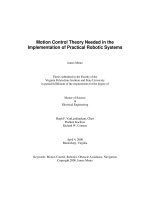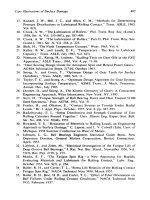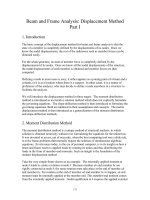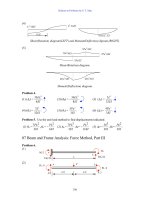Motion Control Theory Needed In The Implementation Of Practical Robotic Systems 2 Part 8 ppsx
Bạn đang xem bản rút gọn của tài liệu. Xem và tải ngay bản đầy đủ của tài liệu tại đây (154.84 KB, 8 trang )
Chapter 5 Soft Computing
49
nine possible rules so it is reasonable to use each rule. These rules are presented in a more
compact form in Table 5.1.
Table 5.1 Weight Given to PID Controllers Torque Command.
AND the Pendulum Velocity is
THEN the SMC’s weight is
Small Medium Large
Small Small Medium Large
Medium Medium Medium Large
IF the
Pendulum
Angle is
Large Large Large Large
The basis of Fuzzy Logic is that the concepts of Small, Medium, and Large can
represent fuzzy sets instead of crisp sets. There is no single value above which the
pendulum angle is Large. Instead, the angle has varying degrees of largeness that increase
with the angle until it can be described as wholly large. In this example the angle and
velocity are limited to a discrete Universe of Discord. The absolute values of pendulum
angle and velocity are limited to 40° and 30 RPM respectively and discretized to one
hundred distinct values. Each value is assigned an amount of smallness, mediumness, or
largeness between zero and one.
The output is also described in terms of a membership functions on an output
universe of discord of zero to 100 percent use of the SMC’s output. The input and output
membership functions are illustrated in Figure 5.3. For creating the output universe of
discord 100 discrete values are used but the resulting output is not rounded to the nearest
whole value. There are 10,000 possible combinations of two inputs with 100 outputs, so
the entire input/output space of the system can be stored as a look-up table with 10,000
outputs. Choosing 16 bit integers for 65,536 possible outputs provided adequate
resolution in simulation and results in a 20,000 byte look-up table, making it practical for
implementation on a DSP. The surface mapped by this table is illustrated in Figure 5.4.
Chapter 5 Soft Computing
50
0
20
40
60
80
100
0
0.5
1
1.5
Angle
S
M
L
0
20
40
60
80
100
0
0.5
1
1.5
Velocity
S
M
L
0
20
40
60
80
100
0
0.5
1
1.5
Percent SMC
S
M
L
Figure 5.3. Input (Angle and Velocity) and Output (Percent SMC) Membership Functions
Figure 5.4. This surface maps the input/output behavior of the controller.
Chapter 5 Soft Computing
51
A fuzzy inference system is used to generate the input/output mapping. Jang et. al.
[34] suggest several such systems. A simple system can be used here because of a
restriction placed on the membership functions: At any velocity or angle in Figure 5.3 the
sum of a given value’s membership in each linguistic variable is unity.
The measured angle’s membership in the Small, Medium, and Large set is
calculated from the angle’s Universe of Discord in Figure 5.3. The measured velocity’s
membership in each set is also calculated. Then each linguistic rule is evaluated. The
THEN part of each linguistic rule is taken to be as true as the minimum value of each part
of the ANDed conditions. This evaluation of THEN statements is shown in Table 5.2.
The membership values are given for an angle and velocity both at 33 in their discrete
Universe of Discord, as shown in Figure 5.3.
Table 5.2 Weight Given to PID Controllers Torque Command.
AND the Pendulum Velocity is
THEN the SMC’s weight is
Small
(25%)
Medium
(75%)
Large
(0%)
Small
(50%)
Small
(25%)
Medium
(50%)
Large
(0%)
Medium
(50%)
Medium
(25%)
Medium
(50%)
Large
(0%)
IF the
Pendulum
Angle is
Large
(0%)
Large
(0%)
Large
(0%)
Large
(0%)
The output weight’s Universe of Discord is then redrawn with each membership
function’s value limited to the maximum value of that membership function allowed by
the linguistic rules. In this case each membership function is limited to the magnitude:
Small 25%
Medium 50%
Large 0%
Chapter 5 Soft Computing
52
In the output universe the resulting shape is the yellow area shown in Figure 5.5.
The x centroid of this shape, x , is used as the output value of the system. The range of
possible outputs is scaled so that centroid of the purely small shape results in 100% PID
control and the centroid of the purely large shape results in 100% SMC control. For the
example in Figure 5.5 the x centroid corresponds to about half PID control, which is
consistent with that point on the mapping in Figure 5.4. Many “centers” of the shape
other than the centroid, such as the mean of the maximum value, may be used.
0 20 40 60 80 100
0
0.5
1
1.5
Percent SMC
S M L
x
Figure 5.5. The final shape used to calculate the output and its centroid.
Results and Conclusion
Simulation results for the system are shown in Figures 5.6, 5.7, and 5.8. Figure
5.6 shows that for a small initial displacement of 10° the hybrid controller behaves
similar to the PID controller and the SMC controller has problems with oscillations
around the setpoint.
Figure 5.7 shows a moderate disturbance of 25°. Here the PID still slowly
converges and the SMC converges quickly but oscillates. The hybrid controller shows the
best response by any of the usual measures, it both converges quicker and has less
overshoot than either of the other methods.
Chapter 5 Soft Computing
53
Figure 5.8 shows a large disturbance of 45°. Here the PID actually goes unstable,
falls down to 180°, and keeps spinning the disk. The hybrid controller is still stable,
converges quickly, and does not oscillate like the SMC.
This chapter shows how the performance of a PID system can be improved by
adding an SMC and using Fuzzy Logic to create a soft switch between them. The model
in (5.1) is only used to simulate the system, not to design the controller. The resulting
hybrid system can be tuned automatically with a neuro-fuzzy tuner or manually by an
expert as was done here without the need to do a complicated mathematical analysis of
the system. The ability to tune a system and improve performance without requiring a
detailed system model and expensive or difficult to gather parameters makes Fuzzy Logic
and other soft computing methods appealing to industry.
Chapter 5 Soft Computing
54
0 5 10 15 20
-10
-5
0
5
10
Pendulum Angle (degrees)
0 5 10 15 20
-20
-10
0
10
20
Pendulum Speed (rpm)
0 5 10 15 20
-100
-50
0
50
100
150
Disk Position (degrees)
0 5 10 15 20
-100
-50
0
50
100
Disk Speed (rpm)
Figure 5.6. The pendulum and disk angle and speed in response to a 10
°
disturbance.
SMC
PID
Fuzzy Hybrid
Chapter 5 Soft Computing
55
0 5 10 15 20
-40
-20
0
20
40
Pendulum Angle (degrees)
0 5 10 15 20
-40
-20
0
20
40
Pendulum Speed (rpm)
0 5 10 15 20
-400
-200
0
200
400
Disk Position (degrees)
0 5 10 15 20
-200
-100
0
100
200
Disk Speed (rpm)
Figure 5.7. The pendulum and disk angle and speed in response to a 25
°
disturbance.
SMC
PID
Fuzzy Hybrid
Chapter 5 Soft Computing
56
0 5 10 15 20
-300
-200
-100
0
100
Pendulum Angle (degrees)
0 5 10 15 20
-100
-50
0
50
Pendulum Speed (rpm)
0 5 10 15 20
-15
-10
-5
0
5
x 10
4
Disk Position (degrees)
0 5 10 15 20
-1500
-1000
-500
0
500
Disk Speed (rpm)
Figure 5.8. The pendulum and disk angle and speed in response to a 45
°
disturbance.
SMC
PID
Fuzzy Hybrid









